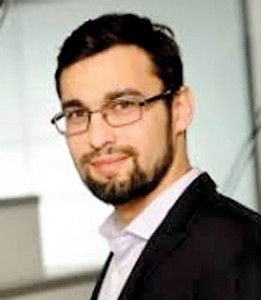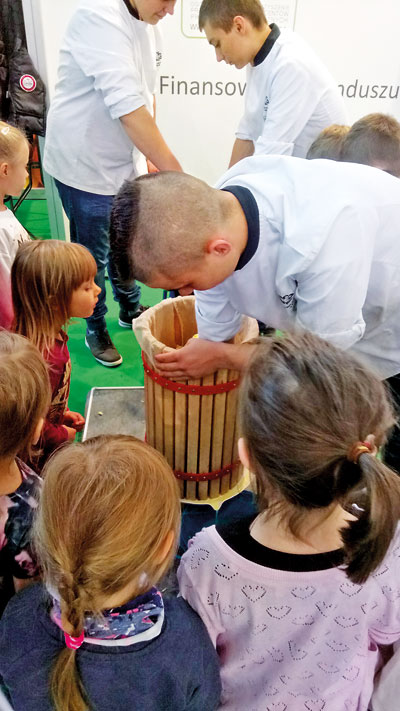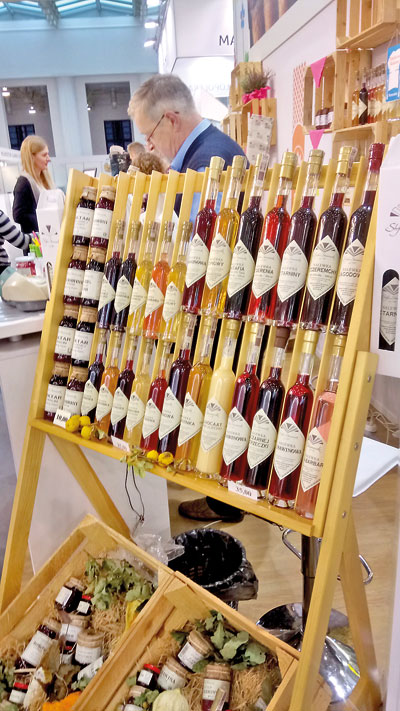Musical apples, dancing chickens and food for the soul!
POZNAN, Poland – The first thing that drew the attention of visitors to the opening day of the Pologra International food fair show in Poznan, 310 km away from Warsaw, the capital of Poland, on Tuesday, September 26 was several happy, giggly children and people with disabilities in groups being shown around the exhibition centre.

Lukasz Holubowski
It reminded me of an industrial exhibition in the mid-1960s which I visited as a school boy accompanied by my father. I am not sure whether children are taken to the numerous exhibitions nowadays in Colombo (which have become more commercial than educational in nature) and, given this Poland experience, this was a wake-up call. Apart from also providing access to people with disabilities, these are events that should also provide concessions to the elderly and senior citizens. Stall owners are welcoming folks – talking, chatting and laughing with children and the disabled. And with food and samples to take away, it was an enriching experience apart from the knowledge gained.
The Polagra Food and International Trade Fair is one of the biggest food and beverage fairs organised in Central and Eastern Europe, annually attracting over 350 exhibitors from 30 countries. This year it was held from September 25 to 28 and the visitors included a group of journalists from China, India, Vietnam, the UAE and Sri Lanka who were hosted by the Agricultural Market Agency (ARR), an institution under the Ministry of Agriculture and Rural Development. The agency earlier this month merged with the agency responsible for land to jointly form Poland’s National Support Centre for Agriculture.
Unlike the business-like exhibitions and trade shows in Colombo, there was a cross section of people visiting this event on the first day resulting in many children and people with disabilities being shown around. Taken in batches, the children are seen learning, playing, having a culinary class, dabbling with food and watching a wooden juicer turn apples into liquid. When the liquid appears, there are many “oohs and ahs’ as the kids grab a cup and eagerly await their turn to drink the fresh liquid.
The learning process also for people with disabilities is a good takeaway for Sri Lankan organisers of fairs and exhibitions that provide some value and knowledge. It not only becomes an education and fun-filled day out for kids, teaching them a lot in a fun-sort-of-way, but for people with disabilities, it enriches their lives. You could see the hard-to-come smiles on their faces as some were wheeled around, and sense the excitement building within, even though without any expression. Some lessons to learn, if not already being done, for Sri Lankan exhibition organisers, to provide a ‘lovely’ day out to kids and people with disabilities, while helping them acquire knowledge in the process.

Eager children watching apples being crushed to produce juice.
Proud tradition of agriculture
There are a couple of developments that Poland is proud of, main among these being its rich agriculture history and tradition. It’s a leader in Europe in most farm products including poultry and different types of meat products. The vegetables and fruits are fresh.
Back to the exhibition itself, there were many briefings from different interest groups amidst strolling around in the giant exhibition centre and looking at the many products and produce on show. One of the briefings is by Lukasz Holubowski, Deputy Director General of the National Support Centre for Agriculture, known by its Polish acronym of (KOWR), official host of this tour of senior writers to Poland.
“Our focus is on innovation, developing new products, fashionable products and new trends. Challenges come from the medical properties and what we eat. We prepare food free of pesticides. Poland is one of the biggest food producers in Europe,” says Mr. Holubowski, who is joined by his colleague, also a deputy Director General, who explains that Poland is seeking economic and agriculture cooperation with other European countries and Asia.
Responding to questions, the two officials say farmers are subsidised in Europe but point out that such subsidies are mostly through technical assistance. “We promote exports a lot and looking for investors from Arab states too,” one of the officials explains.

A rack of wines at the fair.
The Polish food industry, it was revealed, is among the strongest in Europe and known for its innovations. Asked whether scientists are well paid in Poland, they said that while the salaries might not be very high, they prefer to work in Poland, instead of moving to other parts of Europe. They also get special allowances for project-based work.
The trade balance is in Poland’s favour, exporting food and agriculture products annually worth 25 billion Euros and importing goods to the value of 17 billion Euros. Sri Lanka’s trade experience? The tiny South Asian nation imports double the value of goods it exports with a yawning trade balance necessitating balance of payments support from the International Monetary Fund. Sri Lanka has years to go before transforming into a trade-positive country. Poland’s chief exports in the food sector are dairy, fruits and vegetables, poultry, meat and sweets.
Poultry in humane conditions
The discourse with officials of the National Poultry Industry Council – Chamber of Commerce (one organisation) led to some interesting facts. Seated in a large open stall at the exhibition centre, chamber President President Ratmund Paczkowshi – joined by his colleagues – explains the poultry industry and its growth.
Poland is Europe’s largest poultry (mostly chicken) producer. Turkey, geese and duck are produced in smaller quantities. Production is under humane conditions and high standards following European Union regulations always supervised by vets. Ethical norms govern production. Poland’s poultry exports is valued annually at around 2 billion Euros, representing 0.7 per cent of GDP. Of this, 20 per cent goes to Asia and Africa. Halal chicken represents 8-10 per cent of exports and Poland wants to increase this component as this market is growing.
Labour? Most farms are fully mechanised with some labour coming from Ukraine. For those interested in chicken production, it takes 28-48 days to grow a chicken before slaughter. Growth enhancing hormones are banned in Poland. Polish nationals on average consume 32-33 kg of chicken meat per person annually. The conversation between poultry officials and visiting journalists continues amidst the buzz outside as other visitors occasionally peer into the stall, seemingly amused by the briefing to a group of foreigners!
The conversation continues. The group of visiting journalists is told that a large amount of chicken is exported to other EU countries. They are, by law, produced in humane conditions, good atmospheric conditions and expected to maintain high EU standards. Chickens are subject to regular vet services. Chicken fillet and breast is in demand in Europe while wings and feet are in demand in Asia mainly Vietnam.
And now we come to the end of my article. Hey? What about the musical apples and dancing chickens mentioned in the headline? That was just a teaser. Await the rest of the Poland saga next week!


